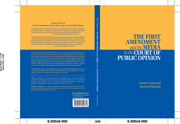Book contents
- Frontmatter
- Contents
- List of Tables and Figures
- Preface and Acknowledgments
- 1 Freedom of the Press and the Power of Public Opinion
- 2 Surveying the Public on Press Freedoms
- 3 What Americans Know About the Freedom of the Press
- 4 Public Support for the Freedom of the Press
- 5 Support for Press Freedoms Across Media: Comparing Print, Electronic, and the “New Media”
- 6 Support for Press Freedoms within a Medium: Elite, Mainstream, and Tabloid News Sources
- 7 Public Opinion, the First Amendment, and the Challenges of the Twenty-First Century
- Appendix: Annotated Questionnaires
- References
- Index
2 - Surveying the Public on Press Freedoms
Published online by Cambridge University Press: 05 June 2012
- Frontmatter
- Contents
- List of Tables and Figures
- Preface and Acknowledgments
- 1 Freedom of the Press and the Power of Public Opinion
- 2 Surveying the Public on Press Freedoms
- 3 What Americans Know About the Freedom of the Press
- 4 Public Support for the Freedom of the Press
- 5 Support for Press Freedoms Across Media: Comparing Print, Electronic, and the “New Media”
- 6 Support for Press Freedoms within a Medium: Elite, Mainstream, and Tabloid News Sources
- 7 Public Opinion, the First Amendment, and the Challenges of the Twenty-First Century
- Appendix: Annotated Questionnaires
- References
- Index
Summary
In Chapter 1 we suggested that – given the right circumstances – the deteriorating reputation of the press as a whole might well place its legitimacy as an American political institution at significant risk. But slipping public support for the press would be especially problematic for the system as a whole if it were to cause equally precipitous drops in public support for the value of freedom of the press in America. The U.S. democratic system relies heavily on the free flow of political information and ideas, and this free flow takes place largely through the robust exercise of First Amendment rights by members of the press.
In this chapter, we offer a multi-layered, theoretical framework to guide our investigation of public support for freedom of the press at the turn of the century. To a degree, the systems theory model developed by David Easton (1975) aids our understanding of the relationship among public opinion, the press, and freedom of the press. It is not our intention here to resurrect systems theory, which has suffered its share of criticisms in recent years. Rather, the systems model merely provides a useful framework for structuring our discussion of the relationship between attitudes about the media and attitudes about press freedoms. We use Easton's model merely as a starting point from which we articulate our central thesis and develop specific hypotheses that will be addressed throughout this book. The second layer of our theoretical framework concerns itself with the way that the “rational public” asserts its interests in a democratic system.
- Type
- Chapter
- Information
- Publisher: Cambridge University PressPrint publication year: 2002



